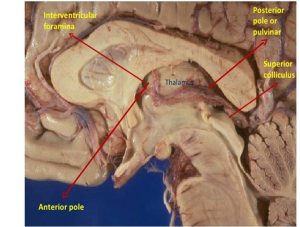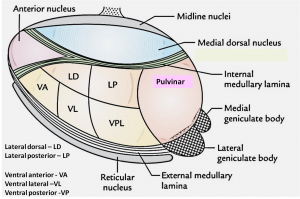Location and external features of Thalamus.
Thalamus ( also known as ‘Gateway to Cerebral Cortex’) is part of diencephalon which is part of brain between the cerebrum above and midbrain below.

Each cerebral hemisphere contains a thalamus (dorsal thalamus), a large egg-shaped mass of grey matter that lies immediately lateral to the third ventricle. The paired thalami (right and left) are connected by the interthalamic adhesion. It has
- Two ends/poles: anterior and posterior. anterior end lies just behind the interventricular foramen and posterior end called pulvinar lies just above and lateral to superior colliculus.
- Four surfaces: superior, inferior, medial and lateral.
- Superior surface: lateral part of superior surface forms the floor of central part of lateral ventricle and the medial part is separated from the lateral ventricle by fornix and tela choroidea.
- Inferior surface is related to hypothalamus.
- Medial surface: Medial surfaces of the two thalami are connected by a mass of grey matter called interthamamic adhesion. It forms the lateral wall of third ventricle and is lined by ependyma.
- Lateral surface is related to internal capsule.
Functions of Thalamus
Thalamus is regarded as integrating centre, where information from all sources is brought together. Thalamus has four basic functional roles:
- Sensory: It is a centre for relay of sensory pathways except olfaction. All sensory information (except olfaction) is relayed to the cortex via the thalamus.
- Motor: Motor system outputs from the basal ganglia and cerebellum are relayed to cerebrum via the thalamus.
- Emotion &memory: Thalamus is part of the Papez circuit and helps control some emotional and memory information going to limbic cortex (cingulate gyrus).
- Consciousness: Thalamic nuclei are connected to reticular activating system , therefore associated with alertness and consciousness.
Structure of Thalamus
Thalamus is mainly composed of gray matter (nuclei) and a small amount of white matter.
- White matter:
- Lateral surface of thalamus is covered by a thin layer of myelinated fibers called External medullay lamina.
- Internally a ‘Y’ shaped white matter sheet called Internal medullary lamina divides thalamus into 3 parts: Anterior, Medial and Lateral.
- Grey matter/ Thalamic nuclei: there are five groups of thalamic nuclei, each with specific connections.

| Nuclei of Thalamus | ||||
|---|---|---|---|---|
| 1 | Anterior group | Anterior nucleus | ||
| 2 | Medial group | Medial dorsal nucleus | ||
| 3 | Lateral group | Dorsal group | Lateral dorsal | |
| Lateral posterior | ||||
| Pulvinar | ||||
| Ventral group | Ventral anterior | |||
| Ventral lateral | ||||
| Ventral posterior | Ventral posteromedial | |||
| Ventral posterolateral | ||||
| 4 | Midline nuclei | Located between medial surface of thalamus and ependyma of third ventricle | ||
| 5 | Intralaminar nuclei | Embedded within the Internal medullary lamina ( most important of these is Centromedian nucleus) |
* The medial and lateral geniculate bodies, traditionally described under Metathalamus are now considered part of thalamus.
Functional classification of nuclei of Thalamus
| Functional group | Nuclei of Thalamus | Function | |
|---|---|---|---|
| 1 | Sensory relay group | Ventral posterolateral | Involved in relaying the sensory input from the body, retina, cochlea and taste receptors to the sensory areas of cerebral cortex |
| Ventroposteromedial | |||
| Medial geniculate body | |||
| Lateral geniculate body | |||
| 2 | Sensory modulator group | Lateral dorsal | Receive input from other thalamic nuclei and realy the information to association areas of cerebrum |
| Lateral posterior | |||
| Pulvinar | |||
| 3 | Motor relay group | Ventral anterior | Convey motor information from the cerebellum and globus pallidus (Basal ganglia) to the motor area of cerebral cortex. |
| Ventral lateral | |||
| 4 | Limbic group | Anterior nucleus | Part of papez circuit for recent memory |
| Medial dorsal nucleus | Involved in controlling emotional state and has role in determining the personality | ||
| 5 | Non-specific group | Intralaminar | Receive nformation from reticular activating system and convey it to all parts of cerebral cortex. Involved in maintaining state of alertness. |
| Midline | |||
| Reticular nucleus |
Connections of Thalamus
Afferents: Thalamus receives
- General and proprioceptive sensory information via ascending tracts spinothalamic tracts, medial lemniscus and trigeminothalmic tract.
- Taste sensation reaches via solitariothalamic fibers.
- Visual and auditory impulses reach via optic radiation and from inferior colliculus respectively.
- Fibers from hypothalamus, hippocampus and reticular formation also reach thalamus.
- It also receives profuse connections from cerebral cortex, corpus striatum and cerebellum.
Efferents: The information received by thalamus is projected to cerebral cortex via thalamocortical fibers which form thalamic radiations. These are :
- Anterior to frontal lobe (cingulate gyrus and prefrontal cortex)
- Superior to parietal lobe (motor and premotor cortex, sensory cortex)
- Posterior to occipital lobe ( primary visual area)
- Inferior to temporal lobe ( primary auditory area)
Projections from thalamus also reach corpus striatum, hypothalmus and reticular formation.
| Nuclei of Thalamus | Afferents | Efferents | Function |
|---|---|---|---|
| Ventral posterolateral | Spinothalamic tracts, medial lemniscus | Primary sensory cortex | Relay touch, pressure, temperature, pain and proprioceptive sensations from the trunk and limbs |
| Ventroposteromedial | Trigeminal lemniscus and tractus solitarious ( taste) | Primary sensory cortex | Relay touch, pressure, temperature, pain and proprioceptive sensations from the head and taste. |
| Medial geniculate body | Inferior colliculus ( part of auditory pathway) | Auditory area of cerebral cortex in temporal lobe | Involved in Hearing |
| Lateral geniculate body | Optic tract from retina | Visual area of cerebral cortex in occipital lobe | Involved in Vision |
| Lateral dorsal | Other thalamic nuclei | Association areas of cerebrum | Modulation of sensory input. |
| Lateral posterior | -do- | -do- | -do- |
| Pulvinar | |||
| Ventral anterior | Globus pallidus, reticular formation | Premotor cortex, reticular formation | Convey motor information from the cerebellum and globus pallidus (Basal ganglia) to the motor area of cerebral cortex. Regulation of movement. |
| Ventral lateral | Dentate nucleus of cerebellum | Premotor and motor cortex | |
| Anterior nucleus | Mamillary body of Hypothalamus, hippocamus | Cingulate gyrus | Part of papez circuit for recent memory, emotional behaviour |
| Medial dorsal nucleus | Hypothalamus | Prefrontal cortex | Involved in controlling emotional state and has role in determining the personality |
| Intralaminar | Reticular formation in brainstem | ALL areas of cerebral cortex via other thalamic nuclei | Involved in maintaining state of alertness. |
| Midline | - do- | -do- | -do- |
| Reticular nucleus | Collaterals of thalmocortical and corticothalamic fibers | Other thalamic nuclei | -do- |
Applied
Thalamic syndrome/ Dejerine Roussy syndrome
This occurs due to occlusion of the branch of posterior cerebral artery that supplies the posterolateral part of thalamus. It is characterized by:
- Pansensory loss on contralateral side of lesion ( due to involvement of ventral posterior nucleus).
- Sudden severe pain ( involvement of non-specific nuclei).
- Transient haemiparesis ( involvement of internal capsule).
- Hameataxia and choreiform movements ( involvements of fibers from cerebellum and globus pallidus).
- Homonymous hemianopia ( involvement of lateral geniculate body).

I firstly want to acknowledge anatomyqa.com. I am a second-year medical student, and I am taking neuroanatomy this semester. This site has really made it easier for me. I have searched for a lecture on the cerebellum but seems was not covered here. I will like to know if there is a lecture on the cerebellum and how I can access it. Thank you.